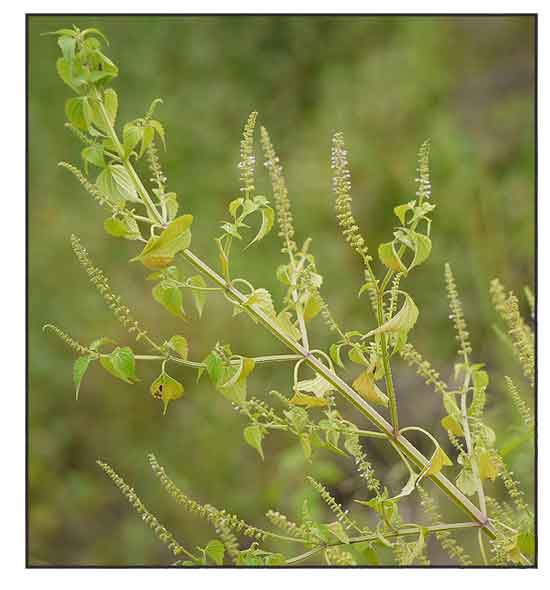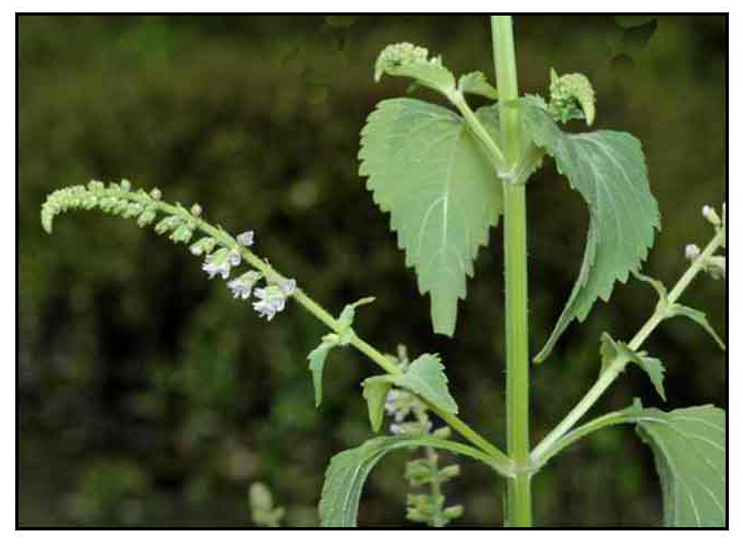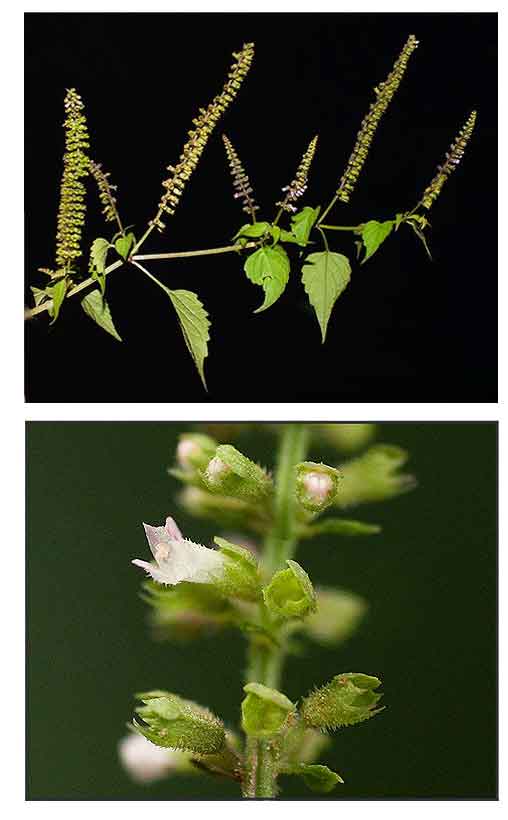 Gen info Gen info
- Lamiaceae is a cosmopolitan family of aromatic and herbal plants, known as the mint family. It is the 6th largest of the angiosperm family, with approximately 236 genera and 7200 species. (4)
-
Basilicum is a genus of plants in the family Lamiaceae, first described in 1802. It contains only one known species, Basilicum polystachyon. (15)
- Etymology: The genus name Basilicum derives from Latin basilicus, meaning "royal" or "kingly", echoing to the Greek basilicon, signifying the same, perhaps referring to the plant's perceived importance or regal status in ancient times. The specific epithet polystachyon derives from Greek root words: poly, meaning "many" and stachys, meaning "spike" or "ear of grain", referring to the many-spiked or many-clustered inflorescence characteristic of the plant.
In short: "a kingly herb with many spikes".
Botany
• Loktokong is an erect, much-branched, nearly smooth herb, 40 to 90 centimeters high. Stems are prominently 4-angled. Leaves are long-stalked, thin, ovate to oblong-ovate, 2 to 6 centimeters long, glandular and hairy on both upper and lower surfaces, with both ends pointed and with toothed margins. Flowers are lilac or pink, about 2.5 millimeters long, numerous, crowded, and borne in racemes 3 to 10 centimeters long and 5 to 6 millimeters in diameter. Calyx, in fruit, is spreading or somewhat reflexed, 3 to 3.5 millimeters long.
• Herbs erect. Stems to 1 m tall, glandular, scabrid on angles, puberulent on nodes. Petiole 1-5 cm; leaf blade lanceolate- to triangular-ovate, 2-7 × 1.2-5.5 cm, membranous, subglabrous, densely golden glandular, base broadly cuneate to rounded, margin crenate above base, apex slightly acute; lateral veins 3- or 4-paired. Thyrses numerous, 3-6 cm, pedunculate, puberulent, glandular; bracts obovate-rhombic, ca. 1.5 mm. Calyx ca. 1.5 mm, ovoid-campanulate, minutely hispid near base, glabrous toward apex, sparsely golden glandular; posterior tooth broadly ovate, apex obtuse; lateral teeth smaller, triangular, apex acute; anterior teeth narrow, lanceolate, apex spinescent; fruiting calyx 2-2.5 mm, ovoid, slightly constricted at throat, declined, posterior tooth margin somewhat decurrent, ± conspicuously 10-veined. Corolla white to reddish, straight, cylindric, ca. 2.5 mm, sparsely puberulent, lips glandular, sparsely puberulent at throat just below upper lip inside, tube ca. 2 mm; upper lip lobes ovate, middle lobe longer; lower lip oblong, margin entire, flat, nearly as long as upper lip. Nutlets brown, ovoid, ca. 1 mm. (Flora of China)
 Distribution Distribution
- Native to the
Philippines. (8) (19)
-
In open, waste places, usually wet or damp soil, and widely scattered in settled areas in the Ilocos Norte, Pampanga, Rizal, Bataan, Laguna, and Quezon Provinces in Luzon; and in Mindanao (Cotobato).
- Also native to Angola, Bangladesh, Benin, Bismarck Archipelago, Borneo, Burkina, Burundi, Cambodia, Cameroon, Central African Republic, Chad, China Southeast, Comoros, Congo, DR Congo, Eswatini, Ethiopia, Ghana, Hainan, India, Ivory Coast, Jawa, Kenya, KwaZulu-Natal, Lesser Sunda Is., Madagascar, Malawi, Malaya, Maluku, Mauritius, Mozambique, Myanmar, New Guinea, Niger, Nigeria, Northern Provinces, Northern Territory, Queensland, Rwanda, Saudi Arabia, Solomon Is., Somalia, Sri Lanka, Sudan-South Sudan, Sulawesi, Sumatera, Taiwan, Tanzania, Thailand, Togo, Uganda, Vietnam, Western Australia, Zambia, Zimbabwe. (8)
Constituents
- Leaves and flowers yield an essential an essential oil with main components of ethyl-eugenol (39%), methyl-isoeugenol (8%), limonene (7%), 1,8-cineole (eucalyptol, 5%), ß-elemene (5%), ß-caryophyllene (5%), ß-selinene (4%), citronellal (3.5%), geranyl acetate (2.9%), α-humulene (2.4%), isobornyl acetate (2%) and d-cadinene (2%).
- Yields alkaloids, phenols, flavonoids, triterpenes, coumarins, saponins, and sterols. (see study below) (11)
- Phytochemical screening of petroleum ether extract of leaves yielded phytosterols; an alcohol extract yielded alkaloids, carbohydrates, glycosides, and phytosterols; water extract yielded alkaloids, carbohydrates glycosides, volatile oils, gums, and mucilage; and an acetone extract yielded alkaloids and phytosterols. (12)
- GC-MS study for volatile oil yielded 64
constituents with main components of sesquiterpenoids and monoterpene. (see study below) (14)
- Study for volatile oil yielded main components of (1) Ylangene (33.43%), (2) Epiglobulol (31.52%), (3) Copaene (6.14%), (4) Verticiol (5.95%), (5) Caryophyllene oxide (3.01%), (6) D-Limonene (2.93%), (7) Caryophyllene (2.13%), (8) 1R-α-Pinene (1.93%), (9) 1,2,4α,5,8,8α-hexahydro-4,7- dimethyl-1-(1-methylethyl) -[1S-(1α,4αα,8αα)]-naphthalene (1.52%). (see study below) (18)
Properties
- Aromatic; belongs to the mint family, and closely allied to coleus and basil.
- Repellent, mosquitocidal.
- Studies have shown mosquitocidal, larvicidal, ovicidal, repellent, antibacterial, antifungal, anticonvulsant, cytotoxic, antioxidant, antibiotic potentiating properties.
 Caution Caution
- Oral consumption of leaves as decoction or infusion reported to cause mouth ulcers.
- Eugenol is toxic in large amounts and can cause contact dermatitis.
Uses
Edibility
- Leaves used to flavor food.
- Leaves used for making herbal tea.
- Caution: Reported to cause oral ulcers in sensitive people.
Folkloric
- No reported folkloric medicinal use in the Philippines.
- The Javanese people use crushed leaves on sprains.
- In Cameroon, leaves used for infectious diseases and gastroenteritis.
- Decoction of leaves reportedly use in epilepsy, heart palpitations, and neuralgic. Various extracts used in health remedies for the common cold, cough, headaches, rheumatism, convulsions, and heart disease. In the Gold Coast, plant juice used for relief of headaches. (4)
- Crushed leaves used as sedative. Fresh roots chewed against cough or cooked with food to reduce flatulence. Infusion of fruit is taken in case of delayed birth in parturition. In children, leaf sap is squeezed into the nostrils to cause sneezing in order to relieve headaches. (6)
Others
- Repellent: In Africa, plant reportedly used as insect repellent. (15) Also used as snake repellent. (16)
Studies
• Mosquitocidal / Ovicidal: Study of leaf extract against C quinquefasciatus showed 100% egg mortality at 100 ml/L. (1)
• Mosquitocidal / Octasane Mosquitocidal compound, octasane, isolated from the leaves of M. polystachyum exhibited larvicidal activity with LC50 value of 7.2 mg/I against Culex quinquefasciatus. Â (2)
• Volatile Oils / Repellency: Volatile oils from leaves of two plants – Moschosma polystachyum and Solanum xanthocarpum were effective as repellents with more than 300 minutes of protection against the bite of Cx quinquefasciatus. Both showed no adverse effects on human volunteers and can be applied as protection against mosquito bites. (3)
• Antimicrobial / Leaves: Phenolic extract of leaves was tested for in vitro antimicrobial activity against five bacteria (E Coli, P aeruginosa, S aureus, B subtilis, M luteus) and three fungi (F oxysporum, A niger, H oryzae). Acidic extract showed high activity against Gram-positive bacteria. Among the fungi, maximum activity was exhibited against Aspergillus niger. The antimicrobial activity might to attributed to high levels of polyphenolic compounds, caffeic acid, and rosmarinic acid. Results showed a promise for ethnopharmacological use as a broad-spectrum antimicrobial. (5)
• Anticonvulsant: Alcohol and aqueous extracts of leaves showed significant antiepileptic activity in both MES-induced and PTZ convulsion models. (7)
• Antibiotic Potentiation Against MDR Gram-Negative Bacteria: Study evaluated methanol extracts of four Cameroonian dietary plants for ability to improve activity of commonly used antibiotics against MDR Gram-negative bacteria expressing active efflux pumps. The MIC of the studied extracts ranged from 256-1024 µg/ml. Basilicum polystachyon recorded the lowest MIC value (256 µg/ml) against E. aerogenes and P. stuartii. The extracts showed synergistic effects (FIC≤0.5) against the studied bacteria, with an average 75.3% of tested antibiotics. (11)
• Antibiotic Potentiation / Synergistic Effects: Study evaluated four Cameroonian dietary plants (Basilicum polystachyon, C. frutescens, Brassica. oleracea var. italica and B. oleracea var butyris) for potentiating activity of commonly used antibiotics against MDR gram-negative bacteria expressing active efflux pumps. All the plants yielded alkaloids, phenols, flavonoids triterpeneds, and sterols. Basilicum polystachyon recorded the lower MIC value (256 µg/ml) against E. aerogenes ATCC 13048 and P. stuartii ATCC 29916. The extracts showed synergistic effects against studied bacteria. (13)
• Volatile Oil / Bioactivity: Study of volatile oil for bioactivity showed antimicrobial (inhibitory effect on 8 plant pathogenic fungi), antioxidant (scavenging of DPPH free radicals), and cytotoxic effects.(see constituents above) (14)
• Larvicidal / Ovicidal / Against Mosquito Vectors: Study evaluated the efficacy of Basilicum polystachon essential oil (EO) in controlling three important mosquito viz., Aedes aegypti, Anopheles stephensi, and Culex quinquefasciatus, using concentration doses of 3.125, 6.25, 12.5, and 50 µl/L. The EO exhibited 100% ovicidal activity at 50 µl/L concentration against eggs of all three species within 24 hours. It showed considerable mosquitocidal activity, with LC50s of 4.25, 6.48, and 4.93 µl/L against As, Cq, and Aa at 24 hours, respectively. No pupicidal activity was observed. Results showed promising larvicidal and ovicidal activities without harming tested natural predators. Study suggests potential as effective alternative to synthetic pesticides for controlling the three common mosquito vectors. (17)
• Antimicrobial / Antioxidant / Cytotoxicity / Essential Oil: Study evaluated the bioactivity of volatile oil in Basilicum polystachyon. GC-MS isolated 64 constituents taking up 99.75% of total peak area. Main composition of the volatile oil is sesquiterpenoid and monoterpene. The VO showed strong antimicrobial, antioxidant, and cytotoxicity activity. (see constituents above) (18)
Availability
Wild-crafted.
|

![]()




 Distribution
Distribution Caution
Caution